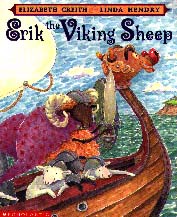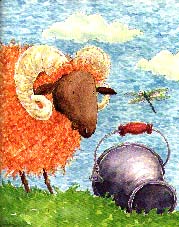


|
Erik the Viking Sheep.
Elizabeth Creith. Illustrated by Linda Hendry.
Subject Headings:
Preschool - grade 2 / Ages 4 - 7.
*** /4
|

excerpt:
Erik was still alone a lot. But now, when he was by himself, he imagined himself as Erik the Viking sheep. He would wear a splendid cloak and a fierce helmet - he already had the horns - and ride at the front of his great dragon-headed ship. He would have a sword and a shield. He was a little confused about what he would do with them, since hooves aren't very good for holding things. But a Viking had to have a sword and a shield, so Erik the Viking Sheep would have them, too.
 When Erik, the farm's new red sheep, arrives from Iceland,he is put in quarantine. He is very lonely until Marie, a little girl, befriends him, nicknaming him Erik the Red. Every day after school, Marie visits his pen and reads to him exciting tales about the Vikings of long ago and their daring adventures. In his imagination, Erik becomes the Viking Sheep, who, dressed in a cloak and helmet and carrying a sword and a shield, leads a shipload of Viking sheep on raids, terrorizing the inhabitants of coastal villages. At last Erik is released into the flock where he proceeds to bore the other sheep with his Viking stories until, eventually, the sheep avoid him completely. One day, Erik finds a bucket, and, curious to find out what it's like to wear a helmet, tries it on his head. When he attempts to pull his head out, the bucket gets stuck, and Erik, thrashing about, lands in a pond. The ducks and sheep have a good laugh at Erik's expense. Discouraged and lonely, Erik promises to stop talking about Vikings and joins the company of the flock, doing "ordinary sheep things." After a few days, some lambs ask Erik to tell them a Viking story. Erik happily obliges but also makes up other kinds of stories as well, eventually becoming the best storyteller in the flock and gaining many friends in the process.
When Erik, the farm's new red sheep, arrives from Iceland,he is put in quarantine. He is very lonely until Marie, a little girl, befriends him, nicknaming him Erik the Red. Every day after school, Marie visits his pen and reads to him exciting tales about the Vikings of long ago and their daring adventures. In his imagination, Erik becomes the Viking Sheep, who, dressed in a cloak and helmet and carrying a sword and a shield, leads a shipload of Viking sheep on raids, terrorizing the inhabitants of coastal villages. At last Erik is released into the flock where he proceeds to bore the other sheep with his Viking stories until, eventually, the sheep avoid him completely. One day, Erik finds a bucket, and, curious to find out what it's like to wear a helmet, tries it on his head. When he attempts to pull his head out, the bucket gets stuck, and Erik, thrashing about, lands in a pond. The ducks and sheep have a good laugh at Erik's expense. Discouraged and lonely, Erik promises to stop talking about Vikings and joins the company of the flock, doing "ordinary sheep things." After a few days, some lambs ask Erik to tell them a Viking story. Erik happily obliges but also makes up other kinds of stories as well, eventually becoming the best storyteller in the flock and gaining many friends in the process.
The book, which can be best described as "cute," will appeal only to the very youngest of primary students. Its predictable plot, simple vocabulary and common themes of wistful thinking, loneliness and the difficulty of making new friends are typical primary fare. Cartoon-like illustrations, done mainly with short brush strokes, suit the text. The majority of the illustrations are double-page spreads.
Consider this book for purchase only if you have money to spare.
Recommended.
Gail Hamilton is a teacher-librarian at Bird's Hill School in East St. Paul, Manitoba.

To comment on this title or this review, send mail to cm@umanitoba.ca.
Copyright © 1998 the Manitoba Library Association. Reproduction for personal use is permitted only if this copyright notice is maintained. Any other reproduction is prohibited without permission.
Published by
The Manitoba Library Association
ISSN 1201-9364
TABLE OF CONTENTS FOR THIS ISSUE - JANUARY 16, 1998.
AUTHORS | TITLES | MEDIA REVIEWS | BOOKSHELF | BACK ISSUES | SEARCH | CMARCHIVE | HOME